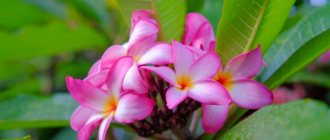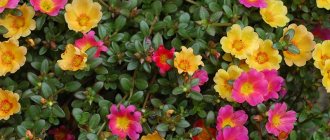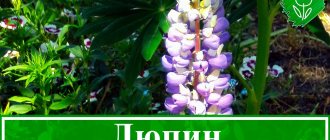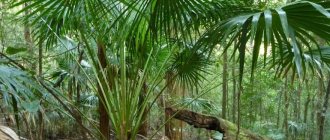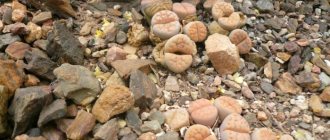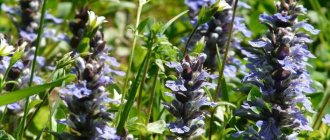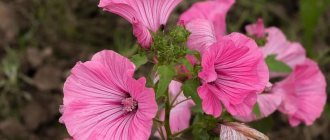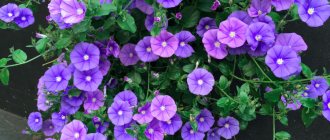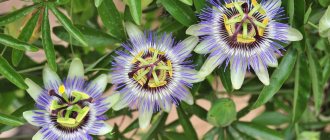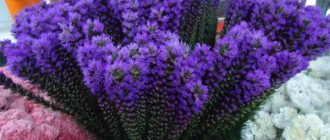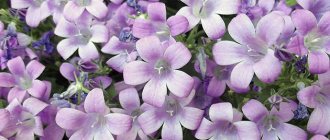The use of this plant for medicinal purposes goes back far into history. In Bulgarian traditional medicine, it was an excellent remedy that improves metabolism, as well as providing benefits for diseases of the gallbladder, stomach and liver. In Austria, a tea was brewed from the tenacious plant to be used for respiratory diseases, and baths from this plant were considered an excellent remedy for “thinness.” During the Crimean War, doctors used it to heal people from malaria.
This amazing plant has a very suitable name for it - tenacious. Outwardly, it is familiar to many who love forays into nature.
This article is about one of the varieties of the plant - the Genevan tenacious.
Features of the plant
Tenacious (or ayuga) is a genus of perennial and annual plants. It belongs to the Lamiaceae (Lamiaceae) family, which has approximately 50 plant species. In the wild, they grow in meadows, forests and wetlands on almost all continents, but mostly in Eurasia.
The essence of the plant is fully reflected by its name. The survivor is so unpretentious that it easily adapts to almost any conditions: it can withstand drought and endure severe frosts.
Members of this genus, depending on the species, grow 5-50 centimeters in height, and many have creeping stems, with semi-evergreen, wintergreen or deciduous leaves with toothed edges. Their flowers are small (two-lipped), collected in spike-shaped inflorescences and false whorls. Their shades vary from yellow and white to blue, indigo, purple or pink. Flowering begins in May and usually lasts until the very end of summer. Most of the survivors are blue, white specimens are the least common.
The brown fruits of the plant are small nuts. In the article you can find a photo of the Geneva survivor.
The most popular varieties
A wide variety of varieties are bred on the basis of creeping tenacious.
Burgundy Glow
Lemon balm - growing from seeds in the country
Vigorous Burgundy Glow is an evergreen and perennial plant. It grows in height from 10 to 25 cm. The leaves are wide. In Moscow, flowering time lasts from April to November. The flowers are purple-violet. They have burgundy and green spots and a white edge.
Black Skellop
The tenacious Black Scallop has dark purple leaf blades. Jagged edges are visible on them. Blue flowers.
Arctic Snow
Grows in any area where there is no sunlight. The leaves are lobed and dark green in color. They grow up to 10 cm in length. They also have a smear in the middle. This species grows to 5-10 cm in length.
Chocolit Chip
This flower has the smallest leaves, only 3-4 cm. They are colored chocolate. The flowers fit tightly together.
Multicolor
Tenacious Multicolor has leaves of different colors. They can be cherry-purple with various spots of cream, pink, and orange. The spots are unevenly spaced. The flowers are blue. They are small in size. Plant height is 10-15 cm. The leaves are large and shiny.
Atropurpurea
The tenacious Atropurpurea grows up to 15 cm. The leaves are brown with a purple and reddish color.
For your information! This species has no shoots.
Tenacious Atropurpurea
Mahogany
The height of the bush is 10-15 cm. The leaves have a rounded shape. They are reddish-purple and black-burgundy in color. Blue flowers.
Varieties
Varieties and types of tenacious differ in the most varied colors of not only flowers, but also leaves: purple, silver-green, bronze-lilac, dark brown. They also come with spots and edges of a wide variety of shades.
Today, the following species are mainly grown as garden ornamental plants.
- The creeping tenacious is the most common species among the representatives of the described genus, mainly growing in Europe. It is characterized by stems 20 cm high, creeping shoots and spike-shaped inflorescences of pink, white, blue-blue and purple colors.
- Herringbone is a low-growing annual plant with bluish-green leaves and yellow flowers that exude a fresh pine scent.
- Geneva tenacious is evergreen, up to 35 cm high. It is distinguished by the absence of creeping shoots, has leaves with large teeth and white or pink flowers.
- Pyramid tenacious is a perennial plant, approximately 20 cm high, characterized by hairy stems, rigid pyramid-shaped leaves and pink, white or lilac flowers. Among them there are quite attractive varieties with metallic-colored leaves. The plant grows very slowly and does not form a cover.
- Pseudochios tenacious has straight, pubescent stems 15 cm high, divided leaves and yellow-purple flowers.
- Laxmanna is a tall, perennial plant distinguished by unusually shaped silvery leaves and yellow or pink flowers.
- Eastern tenacious is a rare species, with white and violet-lilac flowers.
Types of survivors and common varieties
Of course, tenacious is a genus that includes a large number of species and varieties. Gardeners, one way or another, do not cultivate the largest number of species and varieties of ayuga, and at the same time, all cultivated varieties belong to the ground cover species. So this is worth taking into account when less experienced gardeners choose a plant for their plot and want to use it to highlight some of their garden areas.
Creeping tenacious
Under natural conditions, this species can be found almost everywhere in Asia Minor, as well as in North America. In Europe and Iran, this tenacity is also quite common. This species loves to grow among shrub crops, in wooded areas or in meadows, which are also sufficiently moist.
Tough Arctic Snow: Photo of the variety
This is a perennial that is distinguished by incredibly attractive creeping shoots that take root well in any area. The height of the shoots ranges from approximately ten to twenty-five centimeters, and on the surface you can see many very small and soft hairs.
The basal leaves have the shape of rosettes, while they gradually transform in shape into a relatively elongated petiole. The leaves located on the stem are egg-shaped; they can be either sessile or have a very short petiole. The edge may be slightly wavy and has indentations - another feature of the external characteristics of this plant.
The bracts at the very base of the plant are painted in a pale bluish tint, the inflorescences are formed in the shape of a spike, the inflorescences include from six to eight bell-shaped flowers, on the surface of each calyx there is a very attractive and soft pubescence.
The plant begins to bloom either in May or June; the duration of flowering can be approximately three weeks if the plant is in the most comfortable and suitable conditions for itself. The color of the corolla is either blue or light blue, while the flower also has a shortened lip. Among the most popular varieties that are part of this species are the following:
- Arctic snow
This variety was bred by breeders relatively recently, when compared with many other varieties. The leaf blades are wrinkled, may be slightly corrugated, which makes them even more attractive, the shape of the leaves is spatulate, the color is typical deep green, dark.
The leaves are usually about ten centimeters long. In the very center of the leaf blade you can see an attractive wide stroke, painted in an ashen color, and there is also a light outline, which also very much distinguishes the leaf blades of the bush from many other varieties and species.
- Black scallop
The height of these bushes does not exceed ten centimeters, and the minimum height is only five. The leaves are shiny in the sun, have a relief structure, and are colored in an atypical beet-purple hue. The edge of the leaf is uneven, wavy, somewhat similar in shape to a scallop, and cannot help but attract attention; in principle, due to the leaves, this variety is so popular among all other varieties of tenacious.
Tough Black Scallop: Photo of the variety
If the plant grows in more sunlit areas, then there is a high probability that the color will become even deeper and more saturated, and this, of course, is only a plus for this plant
— Chocolit chip
The height of the bush is only five centimeters, the length of the small and shiny leaves is approximately six centimeters, and they barely reach two centimeters in width. Moreover, the shape of the leaves is elliptical, the color can be both purple and dark green, sometimes the leaves can shimmer, which also makes them very attractive and incredibly pleasant to the touch.
Tenacious Chocolit Chip: Photo of the variety
If such a variety is grown in partial shade or shade, then its decorative qualities will not decrease or suffer in any way, and this is truly a huge advantage that should not be forgotten at all.
- Multicolor
Another variety of tenacious, which we will describe in this article. The plant is one of the most decorative of all, and now we will give an explanation of why this is so. The color of the leaf blades of a shrub can be different, everything will depend on how well-lit the place is the plant is located.
Tenacious Multicolor: Photo of the variety
For example, if a tenacious plant of this variety grows in the shade, its color will be dark green; stains of a yellowish or pinkish tint can also be seen on the leaf blades. If the bush grows in a well-lit and sunny place, then the leaves will be painted in a very rich purple hue. On its surface there will be scarlet or orange, sometimes bright yellow stains and fragments; in the overall picture it will look simply wonderful
- Burgundy glow
This variety is distinguished by its attractiveness and demand among gardeners. The leaf blades are painted in violet or purple shades; you can see a cream-colored border on them. In the very center of the leaves there are reddish and pinkish spots that have no shape.
Tenacious Burgundy Glow: Photo of the variety
When the plant grows in the shade, the color of the leaves becomes even more saturated and dark, it really looks just wonderful and decorative. For this reason, the variety is in great demand today among gardeners, decorators, and designers who design landscapes.
- Sparkler
The color of this variety is a very bright blue. The leaves are small, located in very large numbers; on the surface of the leaves there are strokes, as well as strokes, painted white. Sometimes there are touches of pink or cream color, which are also attractive.
Of course, the plant looks great in the garden; it can be combined with many other plantings, plants and crops, garden or herbaceous. Sparkler also looks great as a single planting, so in principle you should pay special attention to it when choosing certain varieties, crops, and herbaceous plantings.
Tenacious Sparkler: Photo of the variety
Also in this species category there are several more varieties that are very popular and, of course, stand out not only for their hardiness, but also for their bright colors. Among these varieties are Sparkler, Variegata, Catlin's Giant, Dixie Chip, Toffee Chip, Rainbow, Silver Queen, Pink Elf and many others. From the names it may be clear that these plants are distinguished by excellent external characteristics, and in principle they are so attractive that it is almost impossible to take your eyes off them.
Pyramidal survivor
The second type that we will consider in this article is pyramidal tenacious. The homeland of this species is Europe, but as for its growing preferences, it is mainly either areas between bushes or rocky terrain.
Tenacious Crispa: Photo of the variety
The height of the bush reaches 25 centimeters; on the surface of the leaf blades of the plant there is an elongated pile, which is very pleasant to the touch. The length of the peduncles is no more than ten centimeters; they contain flowers painted in white and pink, rich purple shades.
It is also worth highlighting several of the most popular varieties, which stand out very much for their features and characteristics:
- Lunar landing
This variety is very unusual, the flowers are mostly yellow in color, which is quite difficult to describe, since they are indescribable. Riotto created this variety, and in his opinion, this plant has both ugliness and beauty at the same time, so the choice of gardeners here will be determined only by whether they want to see this plant on their site, or whether they will still see more in this plant ugliness and absurdity
- Crispa
The leaf blades are large, compressed, and colored green. The color of the flowers themselves is blue, they look simply wonderful, decorative and attract attention.
- Metallica Crisp
A low-growing bush, the height of which reaches only five centimeters. The leaf blades are small, compressed, green or purple in color, and have a metallic tint to the leaves. In general, the plants look very attractive and interesting, especially in group plantings with other varieties of tenacious plants, or with other species and crops.
Tough Metallica Crispa: Photo of the variety
Geneva's tenacious
In its natural conditions, the species can only be found in Asia Minor and Europe, as well as in Iran. The flower takes root well in wooded areas and meadows, among shrubs, and can also easily survive shading without losing its decorative properties and characteristics.
Tenacious Geneva: Photo of the variety
The height of the shoots can vary from five centimeters to 40 centimeters. The leaf blades have short petioles, sessile, and are elongated and elliptical in shape. Along the edges of the leaves there are teeth, which also look very elegant and pleasant.
The color of the flowers can be blue or white; there are pink flowers that have a small upper lip and look miniature, but at the same time quite bright. The flowers are collected in inflorescences of 2-6 each, which look like a spike. The bracts can be small-toothed or three-lobed.
Flowering occurs in May-June, the stems of the plant do not spread, and therefore here you don’t have to worry at all about the fact that the plant needs some kind of limiters so as not to spread out in different directions at all.
Chios tenacious
In the wild, the species can be found in the Caucasus, Mediterranean, and also in regions located in Asia Minor. The tenacious plant grows well there in rocky areas, as well as along roadsides, in steppes or screes.
Chios tenacious: Photo of the variety
The height of the perennial usually does not exceed twenty centimeters, at the base the shoots can be too branched, and sometimes they can simply be erect; the shape depends on what variety this plant belongs to.
The inflorescences have a false spike shape, they are located at the very tips of the shoots, the flowers are formed in the form of bunches. The flowers are painted yellow; on their surface you can not only notice, but also feel the dense pubescence. This type is different in that it has a wound healing effect, so it is not just decorative, but also very useful.
Laksman's tenacity
This species is very unusual, the height of the bush varies from twenty centimeters to half a meter, the shoots are very pubescent and covered with dense foliage. The leaves are large, entire, painted in a white-silver shade, while their shape is more oblong than round.
Laxman's tenacious: Photo of the variety
The flowers are quite small and inconspicuous, so people don’t pay much attention to them when talking directly about the decorative features and characteristics of this plant. The color of the flowers can be pale pink, there is also a light yellow color, here a lot depends on what variety this type of survivor is.
Herringbone tenacious
This is an annual species of tenacious species that reaches only six centimeters in height. The leaves look more like cones - they have a greenish-gray color, the serrations and plates themselves are separate, which looks quite interesting and attractive. The bush is also distinguished by the fact that it emits a very attractive pine scent, and the flowers are yellow. The flowering of the plant begins around May and ends in late autumn, and for this property this plant is also quite popular among gardeners and gardeners.
Turkestan tenacious
In nature, this species can most often be found in Uzbekistan, on the territory of Tajikistan, hence the name of this species. The subshrub is distinguished by the fact that it does not form the largest number of branches. On the thicker shoots there are rather large leaves in the shape of an ellipse, slightly elongated, painted in a pale brownish tint.
The length of the leaves is approximately six centimeters, and the width is about two centimeters, no more. At the very top of the shoots there are flowers that have a very rich purple color. Some flowers have very short and neat stalks, so they look like they are glued to the shoots at the base.
The stems are excellently used for cosmetic purposes, as well as in the field of sports medicine, since they have a sufficient number of positive qualities and traits and are excellent at helping a person cope with certain adversities, which is, of course, very important.
Geneva's tenacious
This perennial plant is also called hairy tenacious. It belongs to the genus Tenacious (in Latin Ajuga). Approximately 15 different representatives of this genus grow in Russia.
The length of the straight, shaggy stems reaches 30 centimeters, and they are covered with medium-sized hairs. It has horizontal roots that form root suckers. The pubescent leaves are oblong and oval in shape, while the basal leaves are larger in size, long-petioled and with teeth.
The leaves at the base of the flowers are entire, bluish in color.
The fruit of the Geneva survivor consists of 4 dark brown, slightly pubescent and wrinkled nuts of a round, ovoid shape up to three millimeters long.
Traditional medicine recipes
- In the treatment of diarrhea, gastric and pulmonary diseases, and inflammatory diseases of the genitourinary tract, an infusion of dry, powdered flowers and leaves of the creeping herb is used. Two tablespoons of raw materials are poured into a porcelain or glass bowl and poured with a glass of boiling water, then closed with a lid and left for 2 hours, wrapped in a warm scarf or napkin. Take 3 times a day, 1 tablespoon.
- Peptic ulcers of the stomach and duodenum, gastritis are treated with the same infusion and taken hot, one tablespoon 5 times a day. This remedy will also be useful for malaria.
- For colds and feverish conditions, you can prepare a weak infusion from the following collection: creeping tenacious, lemon balm, oregano and linden blossom. All herbs are taken equally, brewed and drunk in this tea to expel harmful substances from the body through sweat, as well as reduce fever. This recipe is especially good to use if the patient has stomach problems. Taking aspirin can cause an exacerbation of ulcers or gastritis, but herbal preparations do not have this side effect.
- If you have problems with your hair (loss, poor growth, or even baldness at the very beginning), you should often wash your hair with an infusion of tenacious.
- When stung by a bee, wasp or other insects, you need to rub fresh leaves between your fingers and apply to the affected area, this will reduce pain and irritation, and eliminate the threat of infection. Also, fresh leaves and juice of the plant can be applied to long-term or fresh wounds, ulcers and abscesses in the form of cold compresses and lotions. This will help the rapid healing of both new and old wounds.
- Creeping tenacity will also help with excessive thinness, when weight does not correspond to height and age, even with sufficient and varied nutrition. In this case, the herbal infusion is added to the bath water and the procedures are taken at night; there are no contraindications in terms of timing, the plant is not poisonous.
- Tea prepared from a mixture of fresh or dried leaves of tenacious, linden blossom and lemon balm is an excellent antipyretic that perfectly replaces acetylsalicylic acid. This tea is especially relevant for those who suffer from peptic ulcers and cannot take medications that irritate the gastric mucosa.
- To treat uterine bleeding, a medicinal mixture is used, consisting of the herb creeping tenacious, shepherd's bag, burberry, nettle, damask and lavender, leaves of pear and mantle, shoots of blueberry, barberry bark, steelberry root. These plants are carefully crushed. We take them in equal parts. 8 grams of the finished mixture are poured into two glasses of boiling water, boiled for about three minutes and set aside to infuse for an hour and a half. Divide the resulting infusion into three parts and drink it throughout the day, after meals.
- For the treatment of chronic enterocolitis complicated by diarrhea, the following collection is used: grass of tenacious, greater warthog, centaury, woodruff and rue, leaves of plantain and gum tree, flowers of mullein and onopordum prickly, as well as the fruit of gray alder. Dry all the ingredients well, grind, mix in equal parts and take ten grams of the finished mixture. Pour boiling water in a volume of 300 milliliters, boil for 3 minutes, pour into a thermos and leave for 2 hours. Divide the resulting infusion into 4 parts and consume during the day before meals.
Spreading
The Geneva plant grows almost throughout Europe, in Central and Asia Minor, the Mediterranean, China, as well as in Iran, Afghanistan and Kurdistan.
It is also found as an alien plant in North America. It can be found in Armenia, Moldova, Ukraine and the Caucasus. The furry survivor in Russia has taken a liking to its entire European part, except for the territories of the Far North.
It grows in meadows, among bushes, on forest edges and clearings.
Growing Geneva tenacious from seeds is also widely used by amateur gardeners.
Description
A low (up to 30 cm) perennial plant is a representative of the Labiatae (Lamiaceae) family. Its second name is ayuga, which also looks attractive. Small flowers adorn the erect stem, which has the added bonus of striking wide leaves.
It is necessary to distinguish between the basic type of plant and its variations. The main type has blue flowers. They may also have petals with a purple or yellow tint. Decorative varieties are pink or white flowers.
Sunny meadows, deciduous forests and dense bushes are places where you can meet the south.
In Russia, such a plant is often called unfading, dubrovka, dubnitsa, neumirashka or vologlodka
Tenacious flowers
The abundantly blooming tenacious plant is delightful with its unusual elegant leaves. But its small flowers, collected in original inflorescences, give the plant a rather spectacular appearance. The tenacious shaggy has mostly blue or bluish flowers, collected in 6-12 pieces in false whorls, while the upper ones are twisted into spike-shaped inflorescences, and the lower ones are spaced apart from each other. At the very base the calyx of the flower is bare, in the upper part it is shaggy.
The plant blooms almost throughout the warm season until the very first frost (mostly from May to August). Depending on the variety, the flowers of the tenacious are white, blue, indigo and pink. They begin to bloom in the very first days of May.
Plant pests and diseases
With proper maintenance and proper care, the ayuga will not get sick. Fungal diseases will affect the plant only if the roots are constantly in water and planting is not limited.
Ayuga is considered a very strong plant and resistant to all kinds of viruses. If, however, signs of late blight, Alternaria or gray rot are detected, then treatment with the necessary drug will completely help to overcome the disease.
If the plant is maximally affected and the signs of the disease are clearly visible, then there is no point in treating it; it is better to remove the source of infection from the site. But gardeners very rarely take such drastic steps. Usually the plant feels great in the garden, grows rhizomes and foliage well, blooms and forms rosettes, and sets seeds.
If with diseases everything is not as bad as it might seem, then with pests it is more difficult.
I really like the lush foliage, and the coolness under the leaves, garden slugs. Not visible from the outside, they are very noticeable under the leaves, and the result of their damage is immediately visible. The leaves of the plant are holed in many places or completely eaten. Fighting slugs is very difficult. Some people add wood ash under the plant, while others add slaked lime and egg shells. You can purchase special products that will help get rid of not only slugs, but also snails that actively attack after rain.
Sometimes on the green ayuga you can see black and green aphids - lovers of succulent foliage.
To combat insect pests, various insecticides are used, which help get rid of the scourge for a long time.
About the use of tenacity in landscape design and in everyday life
In gardening culture, it is the Geneva plant that is widely used. Planting and caring for it will not be difficult. The plant is used as a ground cover, looking amazing in lawns, borders, rockeries and large rock gardens, as well as near ponds. It is often planted under bushes and trees, as well as in containers.
There are also varieties used in cooking and medicine. Young leaves are used in salads and as a seasoning for various dishes. The stems have tonic, anti-inflammatory and hemostatic properties, and also prevent baldness.
Caring for the survivor
Soil composition - any, location - any, in accordance with your design ideas . You should just avoid planting the survivor in open sunny areas, because... in hot summers, variegated varieties can be damaged by burns from the midday sun.
Caring for adult plants comes down to single watering in case of extremely dry summers , as well as limiting growth, unless your plans include excessive growth of the color accent from the tenacious plant throughout the rock garden. During prolonged rainy weather, the succulent leaves of the tenacious plant become attractive to slugs, but the scale of damage usually does not reach the point of catastrophe. However, in order to prevent the proliferation of pests and their spread to other plants, it is advisable to treat them with special preparations or folk remedies such as mustard solution (100 - 200 grams per bucket of water) or hot pepper powder. Pollination and spraying of plants should be carried out late in the evening when slugs and snails are active. If the plantings are young and the foliage cover is not yet dense, you can scatter crushed eggshells between the plants, making it difficult for pests to move.
Every two to three years, as for any other perennials, it is a good idea to add a small layer of new, light-composition fertile soil , however, this recommendation is not strict, and the creeping tenacious plant can easily do without this procedure.
The vegetative mass of creeping tenacious plantings older than three years can be damaged under the snow , and the aesthetic effect deteriorates for some time. In spring, the plants recover quite quickly.
The most relevant varieties of creeping tenacious in domestic floriculture: “Atropurpurea” (Atropurpurea) with shiny burgundy-brown leaves, “Multicolor” (Multicolor) which does not form creeping shoots and with variegated spots on the leaves, “Burgundy Glow” with burgundy leaves with a light border in various shades of pink and "Chocolate Chip" with narrow brownish foliage and discreet growth.
As mentioned above, creeping tenacious is ideal as a ground cover plant . It is especially convenient to use the grit in places that are difficult to reach for mowing: in tree trunks, along the edges of reservoirs, in the corners of fences and buildings. To design recreation areas, it is good to place the tenacious plant in the foreground of large flower beds, as a border along garden paths, as well as between stones in alpine hills in the vicinity of irises, rudbeckia, loosestrife, delphinium and others, to your taste. If you have a lot of planting material, you can use creeping tenacious for container group plantings and individually. In addition, there is a place for ayuga in the garden of medicinal plants. In early spring, you can experiment with keeping tenacious as a potted crop on the balcony as a supplier of salad greens.
In the southern regions, it is advisable to use creeping tenacious when there is a need for year-round green (or variegated) lawn coverage.
Ayuga is not suitable for lawns intended for walking and walking pets . An ayuga covering can withstand occasional damage from trampling, but even walking across a grass lawn 1-2 times a week can negate all the work involved in its arrangement.
It also makes sense to clarify that tenacity is not of interest to deer, which may be relevant for owners of remote summer cottages who are faced with the problem of raids by these animals.
Growing Geneva tenacious
Many varieties of tenacious are considered unpretentious; they adapt to growing in a wide variety of soils and under a variety of conditions. There is one caveat - it prefers rich humus and well-moistened soils. With all this, it can do without watering during the hot period for 4 weeks. The plant can grow in one place for up to several years. It is not afraid of frosts (if there is snow cover) or bright sun rays.
The main care for the tenacious plant is the application of mineral and organic fertilizers in the spring, watering during periods of drought, and the removal of already faded inflorescences. In variegated varieties, it is necessary to remove rosettes with monochromatic leaves and replant them every 3-4 years, due to the freezing of old leaves in winter.
Ayuga, care and cultivation
I advise growing ayuga among garden flowers for those who do not really like to deal with capricious plants. It does not need to be replanted often - the decorative appearance of ayuga will delight you for several years. Moreover, the flower does not need frequent watering, which makes it simply an ideal plant among garden flowers.
Watering ayuga
You can leave the survivor without water for about three weeks, or even for a month in not very hot weather. True, by the end of the proposed period the flower may fade slightly, but will recover perfectly with abundant “soldering.”
But pay attention - a young plant still needs to be watered more often, at least until the root system takes root. If, after frost, a perennial ayuga emerges slightly frostbitten, do not be discouraged - a little time will pass and the plant will shine with pure colors
Soil for ayuga
As for the growing soil, tenacious can be planted in almost any soil. You can create a flower bed for ajuga where you would not do it for sensitive garden flowers. I tried to plant ajuga in places where it is almost always damp and in areas scorched by the sun - the tenacious plant feels equally good in any conditions. Moreover, you should not worry about ayuga in case of fairly strong, but short-term frosts - the plant will withstand even ten degrees of frost.
But, nevertheless, I would recommend that gardeners pay a little attention to this unpretentious plant in early spring. A little regular fertilizer for garden flowers, and ayuga will steadily withstand all the vagaries of the weather. Also, do not neglect to water abundantly in dry weather, and the bright colors of the tenacious will remain in sight even after the grass around it dries out.
Neither wet soil nor sharp cold can harm the ayuga. However, in cool weather, an unkempt plant can become a tasty morsel for slugs. To avoid the appearance of snails, I carefully clean the areas where the snails grow from debris - leaves and stones. But if the slug attack is quite impressive, then I advise you to spread a little superphosphate on polyethylene near the plant.
Reproduction
Growing Geneva tenacious from seeds is possible (in autumn or spring), but such propagation by gardeners is usually rarely practiced. In nature, they spread thanks to ants.
The plant can also be propagated vegetatively. In April-September, heavily overgrown bushes should be divided into rosettes for subsequent rooting. It should be noted that even small rosettes with very small roots take root quite easily in the ground.
They are planted at a distance of approximately 20 centimeters between seedlings. The apical bud should be above the soil surface. The plant needs to be watered daily only in the first week after planting in the ground.
How to propagate the Ayuga plant
In addition to the seed method, this grass also reproduces vegetatively. This can be done in spring or autumn. Cut off the rosettes that have grown on the bushes, then plant them in a new place - 1 or 2 pieces each. Even if the rosette only has one thin root, it will still take root, don’t worry about it.
When replanting plants annually, this process is performed once a year, the distance should be no more than 15 cm. If replanting is carried out every 2 years, then the distance is 25 centimeters. First, the planted bushes are watered abundantly, and after rooting, the procedure stops.
Possible difficulties during cultivation
Due to its unpretentiousness, the tenacious plant rarely gets sick, but too much moisture can lead to rot, and during spring floods its leaves can completely die off.
What is special about this plant? It contains unique phytoecdysteroids that inhibit the development of pests, especially their larvae. Sometimes the tenacious plant is attacked by snails and slugs, which mercilessly eat their leaves.
To avoid such situations, it is necessary to remove fallen leaves and other debris from the site, use specialized preparations (“Metu” or “Thunderstorm”) and drain the soil.
Below in the article we present the most common varieties of Geneva tenacious (Helena and Blue Sea), used by amateur flower growers.
Preparatory work
Having chosen the variety most suitable for the site and your purposes, it is important to prepare the material, soil and choose the planting time.
When to plant
There is one requirement in this matter: stable heat. The plant does not tolerate frost well, but tolerates cool weather quite well. Therefore, tenacious plants are planted throughout the season: from May to August (or September in regions with warm climates).
Where to place
It is most logical to select a variety of tenacious, based on your flowerbed site. If you need to plant a beautiful carpet in a sunny place, use the Polar Fox variety. For shade and partial shade the choice is much wider: this is the favorite place for most ayugas.
Important! You should not plant the tenacious plant like lawn grass: it can die even with a single pass over it. An ugly bald spot will form, which will take time to remove.
Delicate primroses and other touch-me-nots cannot stand being in the vicinity of the life-loving ayuga. A lush oak tree will quickly deprive weak neighbors of food and light, and they will die. On the contrary, they get along well with the creeper:
- shrubs of any kind;
- garden trees;
- rudbeckia;
- irises;
- delphinium;
- loosestrife;
- zinnias;
- hosts.
A good solution would be to use survivors for landscaping and moisture retention near the trunks of large trees, in the shade of gazebos and buildings.
Preparing the soil for planting
For better growth, the undying plant is planted on light, fertile types of soil, which ensure the unhindered passage of oxygen to the roots of the plant. Therefore, you will need to prepare the soil for planting by taking in equal parts:
- sand;
- peat;
- top fertile soil layer from the garden bed;
- rotted manure or soil from a compost heap.
All components are mixed well and poured over a drainage layer of expanded clay. The root system of plants is small, so the layer of prepared soil mixture should not be made large, 120-160 mm is enough.
Application
Greens are usually collected during the flowering period, dried under a canopy in the shade, laid out in a not very thick layer (up to 3-5 centimeters).
Tenacious is used widely in folk medicine as a hemostatic, astringent, wound-healing and anti-inflammatory agent. It is used both as an emollient and as an expectorant for diseases of the lungs and respiratory tract. Herbal infusions are also used for diarrhea, colds and female diseases, stomach ulcers, and also for rheumatism. Infusions are used for lotions and washes for eye diseases. Decoctions of this herb are used to gargle and strengthen hair. Wounds are cured with lotions made from crushed leaves. Remedies with this plant help with tuberculosis, rheumatism, gastrointestinal diseases, and it is also indispensable for cholelithiasis.
The survivor has excellent abilities that improve metabolism.
Usually the plant uses the above-ground part. The herb contains flavonoids, essential oils, tannins, iridoids (harpagide, 8-O-acetylharpagide, etc.).
When using products using this plant, it is necessary to take into account individual intolerance and be sure to follow the dosage. Survival is contraindicated for people with a tendency to constipation.
Composition, medicinal properties
Indian onion medicinal properties of a modest plant
The composition of the herbaceous perennial has not been fully studied. However, it is known that the plant is endowed with:
- iridoids;
- steroids;
- tannins;
- essential oils;
- diterpenoids;
- alkaloids;
- saccharides;
- proteins;
- saponins;
- flavonoids;
- bitter substances;
- ascorbic acid;
- vitamin K.
Thanks to its rich composition, the decorative perennial has powerful antiseptic, anti-inflammatory, diaphoretic, astringent, diuretic, wound-healing, expectorant, analgesic, hemostatic, and enveloping properties.
The use of the herb helps:
- normalization of metabolic processes;
- minimizing pain;
- elimination of inflammatory processes;
- normalizing the permeability of cells in the vascular walls, improving their elasticity;
- prevention of vascular sclerosis;
- neutralization of free radicals;
- preventing the destruction of cell membranes;
- prevention of premature aging;
- normalization of the central nervous system, emotional background;
- stimulating the function of the endocrine glands;
- stimulating skin healing;
- increasing the protective properties of the body.
Preparations based on the aerial part of the plant are effective in the fight against such pathological conditions and diseases: alopecia, wounds, ulcers, rheumatism, malaria, colds, tuberculosis, gastrointestinal diseases, stool disorders, cholelithiasis, tonsillitis, urolithiasis, gingivitis.
Healing infusions from tenacious
- To prepare a healthy decoction, you need to pour the chopped herb (8 g) with boiling water (1 glass), cool and strain thoroughly. Take the prepared solution 1 tbsp per day. spoon for stomatitis, sore throat, gingivitis. Freshly squeezed juice can be applied to bee stings, calluses and burns to alleviate the condition.
- 2 teaspoons of flowers and leaves of the plant are infused in 250 grams of hot water for about 1.5-2 hours, then filtered. Take 1 tablespoon of infusion before each meal for diseases of the duodenum and gastric ulcer.
- Infusion of 5 tbsp. spoons of herbs (filled with one liter of boiled water), filtered after three hours. This product washes purulent wounds, moistens burns and rinses the scalp.
Collection and preparation
Usually the herb is used fresh during flowering.
But you can dry it. The collection is carried out during the flowering period, carefully cutting off the apical stem of the plant along with the flowers. The rough lower part is not used. Dry it in the shade in a ventilated area, spreading it out in a thin, even layer. Store in canvas bags or paper bags.
Creeping grass is considered a weed and in some cases an invasive plant. In the landscape it is used as a ground cover plant. At the moment, decorative varieties have been bred that look great in borders and rockeries.
How a good honey plant attracts bees and other insects to the garden.
As a medicinal plant, it has a powerful effect on all organs and can help cope with various problems.
We must not forget about contraindications and side effects. Only then can we make the most of what nature gives us.
https://www.ayzdorov.ru/tvtravnik_jivychka.php
https://ltravi.ru/zhkt/zhivuchka-polzuchaya.html
https://ekolekar.com/zhivuchka-polzuchaya.html
Flowers for the local area
Many modern cultivated varieties of this plant, presented in gardening stores, are an excellent decoration for home gardens. For example, flowers with amazingly beautiful names are the tenacious Geneva Helena, a photo of which can be found in the article, and the Blue Sea.
The tenacious Helena is capable of growing even in the most unfavorable conditions - not only in the sun, but also in heavily shaded places, and on the heaviest waterlogged and light dry soils. In addition, it is distinguished by high frost resistance (withstands frosts down to -10 ° C).
Growing tenacious Geneva Helena from seeds is the easiest and simplest way.
The variety reproduces well and feels good, growing quickly on mountain slopes, among stones, along paths in border plantings, under bushes and trees. It is good because it quickly forms a thick, dense cover.
The tenacious Geneva Blue Sea is also capable of growing in any conditions. It has shaggy creeping stems up to 20 centimeters high. The dark green leaves are shiny, elliptical in shape, with jagged edges. Suitable for both container decoration and as an hanging plant.
Tenacious seeds recommended for planting
Among the many varieties, there are several leaders that are the most popular:
- Tenacious Multicolor, with multi-colored leaves that change when the light falls at different angles. Remaining in the shade, it turns dark green with small splashes of pink and yellow. When sunlight hits the foliage, the color changes to purple interspersed with red and scarlet. The best place for planting is partial shade.
- Chocolate chips, whose foliage is oval and small, are purple or dark green. The grass quickly fills the area, forming a carpet up to 5 cm high. It takes root on loam, both in the shade and in the sun.
- Pink elf has small green leaves. As it develops, the survivor produces a large number of pink inflorescences.
- Dark purple is one of the most popular varieties, characterized by its unpretentiousness to the planting site and light level. And the foliage, painted purple, and blue inflorescences become a worthy decoration of any flower bed.
- A rainbow, with multi-colored foliage, allows you to create a panel on the ground with basic purple and green shades, with frequent inclusions of red, scarlet, white, and yellow spots.
- The polar fox is a tenacious creature that has very beautiful leaves: light green, with snow-white streaks. The stains leave almost no room for the main color of the foliage. The variety does not tolerate planting even in partial shade and is very demanding on soil moisture.
- Polar snow is a modern variety that is just gaining popularity. It attracts with its color: on the dark green background of the leaf there is a large white blotch, as if painted with a brush. The variety is not picky about soil and light levels.
Description of an unusual ayuga flower with photo
Flowering plants of the tenacious plant are very rare, but the tenacious plant does not need flowers: it spreads well by shoots on which young rosettes grow. Often these “babies” grow next to their “mother,” but sometimes the shoot passes between the leaves so that the “baby” ends up sitting on the mother’s rosette. Having grown enough, she falls to the ground. Sometimes this happens from some random push: either a drop of rain, or a kick from a passer-by, or a cone falling from a pine tree, etc., causes the young rosette to tear away from its mother. Having fallen to the ground, the socket, of course, does not always end up in the proper position - with the bottom facing the ground; she can lie on her side, or even completely upside down. This is where it begins to act like a beetle, although incomparably slower. If the rosette lies sideways, its lower leaves are shaded and as a result begin to grow vigorously. These leaves, acting like the elytra of a beetle, rotate the rosette to its normal position.
If the rosette of a tenacious flower has fallen upside down, the rotation is made with the help of roots that act like the legs of a beetle. The root, embedded in the ground, pulls in its direction and causes the rosette to turn. If two or three roots are pulled at the same time, the rotation is in the direction of the “resultant force”. If the roots are accidentally pulled in opposite directions with the same force, the rosette cannot turn and the plant dies.
It is strange that for a long time botanists paid little attention to the unusual turns of young people or survivors. All the more great is the merit of our Soviet botanist N. G. Kholodny, who ten years ago carefully examined and perfectly described this curious feature.
Among the tenacious plants there are evergreen, semi-evergreen, and deciduous plants. The most common in floriculture are decorative deciduous, ground cover perennial ajugas with creeping shoots-stolons that take root in the axils of the leaves.
Blooms in May - June.
